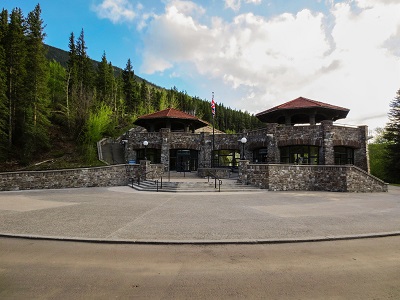Cave and Basin National Historic Site of Canada
Banff National Park of Canada, Alberta

Entrance to Cave and Basin
© Parks Canada | Parcs Canada
Address :
311 Cave Avenue, Banff, Banff National Park of Canada, Alberta
Recognition Statute:
Historic Sites and Monuments Act (R.S.C., 1985, c. H-4)
Designation Date:
1981-11-13
Dates:
-
1883 to 1885
(Significant)
Event, Person, Organization:
-
Walter S. Painter
(Architect)
Other Name(s):
-
Cave and Basin
(Designation Name)
Research Report Number:
1981-051
DFRP Number:
15404 00
Plaque(s)
Existing plaque: 311 Cave Avenue, Banff, Alberta
The Cave and Basin Springs were brought to public attention after being located by CPR construction workers in 1883. These and the Upper Hot Springs soon drew private entrepreneurs and tourists. Growing support for public ownership prompted the federal government to set aside a land reserve here in 1885. Two years later the springs provided the focus of Canada's first national park, Rocky Mountains Park, now called Banff National Park. These hot springs are rightfully known as the birthplace of Canada's national parks, which today span the entire country.
*Note: This designation has been identified for review. A review can be triggered for one of the following reasons - outdated language or terminology, absence of a significant layer of history, factual errors, controversial beliefs and behaviour, or significant new knowledge.
Description of Historic Place
Cave and Basin National Historic Site of Canada is a hot spring located in Banff National Park. The site was developed for public use with a nearby swimming pool and bath-house and is now operated as a historic site open to the public. The official recognition refers to the cave, including its interior pool and the original vent hole, the basin, the hot-spring-fed waters and the vestiges of the building erected next to the vent hole between 1883 and 1885.
Heritage Value
Cave and Basin was designated a national historic site of Canada because it is the birthplace of Canada's national parks.
The heritage value of Cave and Basin National Historic Site of Canada lies in the integrity and legibility of the cultural landscape that developed around the hot springs. The mineral spring issues from Sulphur Mountain where surface water penetrates the rock, absorbing minerals and being heated by geothermal energy to emerge in a cave and in a nearby basin before joining the bow river drainage system below. Long known to local Aboriginal people, the site was found by non-Aboriginal people in 1859 and reserved for public use with the surrounding 16 square kilometres in 1885. By 1887, development of this reserve had evolved into Canada's first national park, the Rocky Mountain Park of Canada.
Sources: Historic Sites and Monuments Board of Canada, Minutes, November 1985; Commemorative Integrity Statement, December 1998.
Character-Defining Elements
Key elements contributing to the heritage value include:
its interior pool, original surface vent hole, the basin (a pool of mineral water) in the open air adjacent to the Cave, the natural springs which flow into the Cave and Basin, and vestiges of the log shanty known as ''the Hotel'' built next to the vent hole between 1883 and 1885 in their extent, geophysical and construction materials; the health and wholeness of the natural features of the cultural landscape inside the Cave and immediately surrounding the Basin; the visual unity and functional inter-relationships between and among these natural features; a continuing flow of warm mineral water into the Cave and Basin from the natural springs; public accessibility to the site; the viewscapes from the site to the surrounding natural setting.